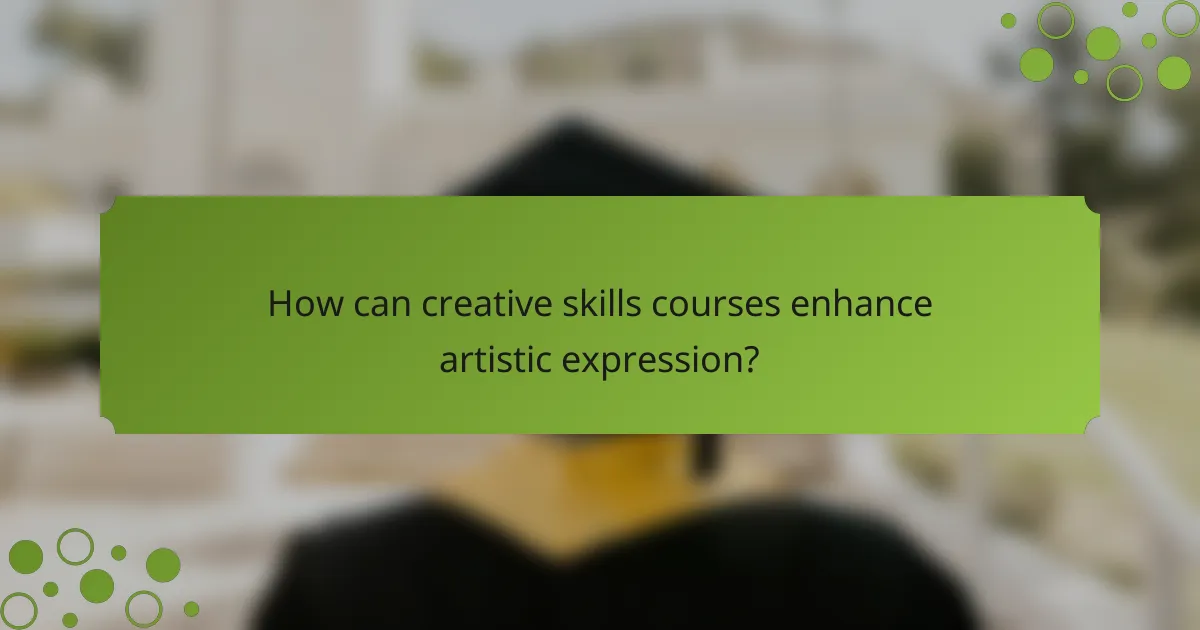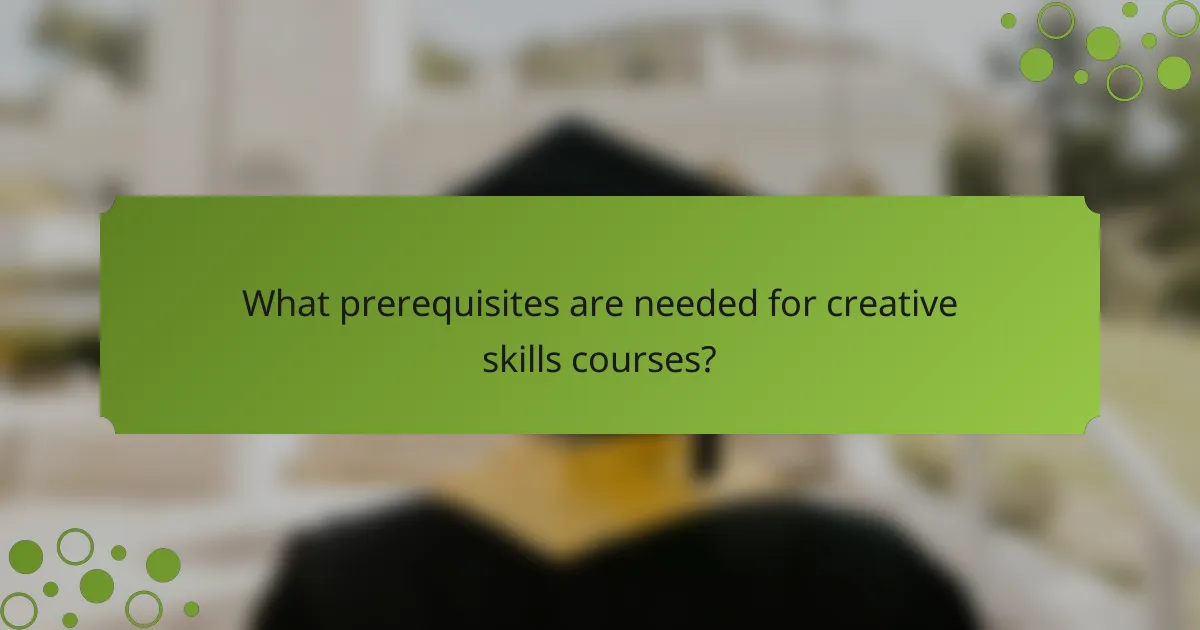
Creative skills courses are designed to enhance artistic expression, aid in portfolio development, and offer valuable feedback from industry professionals. By participating in these structured programs, aspiring creatives can refine their techniques and explore their unique styles, ultimately preparing them for success in their artistic endeavors.

What are the best online creative skills courses?
The best online creative skills courses focus on enhancing artistic expression, developing a professional portfolio, and providing constructive feedback from industry experts. Platforms like Skillshare, Coursera, and Udemy offer tailored programs that cater to these specific needs, making them ideal for aspiring creatives.
Skillshare for artistic expression
Skillshare is a popular platform for those looking to explore and enhance their artistic expression. It offers a wide range of classes in areas such as painting, drawing, photography, and graphic design, taught by experienced artists and creators.
When choosing a course, consider the instructor’s background and the course reviews. Many classes are project-based, allowing you to apply what you learn immediately, which can be beneficial for developing your unique style.
Coursera for portfolio development
Coursera provides comprehensive courses focused on portfolio development, often in partnership with leading universities and institutions. These courses guide you through the process of creating a professional portfolio that showcases your skills and projects effectively.
Look for courses that include peer reviews and feedback sessions, as these features can significantly enhance the quality of your portfolio. Aim to complete projects that align with your career goals, ensuring your portfolio reflects your desired direction in the creative field.
Udemy for professional feedback
Udemy offers a variety of courses that emphasize receiving professional feedback, which is crucial for growth in any creative discipline. Many courses include assignments that allow you to submit work for critique from instructors or fellow students.
When selecting a course, check if it provides personalized feedback options. This can help you identify areas for improvement and refine your skills more effectively. Be proactive in seeking feedback and using it to enhance your creative projects.

How can creative skills courses enhance artistic expression?
Creative skills courses significantly enhance artistic expression by providing structured learning environments that foster creativity and innovation. These courses offer techniques and feedback that help individuals explore their artistic potential and develop unique styles.
Techniques for self-discovery
Self-discovery techniques in creative skills courses often include reflective practices such as journaling, meditation, and guided discussions. These methods encourage artists to explore their emotions, thoughts, and experiences, which can lead to more authentic artistic expression.
Participants may engage in exercises that challenge their comfort zones, such as improvisational activities or collaborative projects. This exploration can reveal hidden talents and preferences, allowing artists to refine their personal style.
Exploration of different mediums
Exploring various artistic mediums is a key component of creative skills courses. Artists can experiment with painting, sculpture, digital art, and mixed media, which broadens their understanding of different techniques and materials. This hands-on experience helps in identifying which mediums resonate most with their artistic vision.
Courses may include workshops that focus on specific mediums, providing participants with the opportunity to learn from professionals. For instance, a painting workshop might cover techniques in oil, acrylic, and watercolor, allowing artists to compare the effects and applications of each medium.

What are the key components of portfolio development?
Portfolio development involves creating a curated collection of your best work that showcases your skills and artistic vision. The key components include building a cohesive body of work and showcasing diverse skills to attract potential clients or employers.
Building a cohesive body of work
A cohesive body of work presents a unified theme or style that reflects your artistic identity. This can be achieved by selecting pieces that share similar techniques, color palettes, or subject matter, which helps convey a clear message about your artistic direction.
When developing your portfolio, aim for a balance between quantity and quality. Typically, a portfolio should contain around 10 to 20 pieces that highlight your strengths while avoiding redundancy. Regularly update your portfolio to remove older works that no longer represent your current skills or style.
Showcasing diverse skills
Showcasing diverse skills is essential to demonstrate your versatility as an artist. Include a variety of mediums, techniques, and styles to appeal to a broader audience and potential clients. For example, if you are a graphic designer, consider including illustrations, branding projects, and digital art.
While diversity is important, ensure that each piece still aligns with your overall artistic vision. Aim to include works that highlight different aspects of your skill set, such as technical proficiency, creativity, and problem-solving abilities. This approach not only enhances your portfolio but also makes you more marketable in competitive creative fields.

How to receive constructive feedback from professionals?
Receiving constructive feedback from professionals involves actively seeking their insights on your work and being open to their suggestions. This process can enhance your artistic expression and improve your portfolio development.
Peer review sessions
Peer review sessions provide an opportunity to gather feedback from fellow creatives who understand your field. These sessions typically involve sharing work in a group setting, where participants can offer insights and critiques based on their perspectives.
To maximize the benefits, establish clear guidelines for feedback, such as focusing on specific aspects like technique or concept. Aim for a balanced approach, encouraging both positive comments and constructive criticism to foster a supportive environment.
Mentorship programs
Mentorship programs connect you with experienced professionals who can provide tailored feedback and guidance. These relationships often involve regular meetings where you can discuss your work, receive advice, and set goals for improvement.
When choosing a mentor, consider their expertise and alignment with your artistic vision. Be proactive in seeking their input and be prepared to implement their suggestions to see meaningful growth in your creative skills.

What prerequisites are needed for creative skills courses?
To enroll in creative skills courses, students typically need basic art supplies and foundational knowledge in art theory. These prerequisites ensure that participants can effectively engage with the course material and develop their artistic abilities.
Basic art supplies
Having the right basic art supplies is essential for any creative skills course. Common items include sketchbooks, pencils, erasers, paints, brushes, and canvases. Depending on the course focus, students may also need specific tools like charcoal, markers, or digital drawing tablets.
When selecting supplies, consider starting with affordable options to test your interests before investing in high-end materials. Many instructors provide a list of recommended supplies, which can help streamline your purchases.
Foundational knowledge in art theory
A solid understanding of art theory is crucial for success in creative skills courses. This includes concepts such as color theory, composition, and the elements of design. Familiarity with these principles allows students to make informed decisions in their artistic practice.
To build this foundational knowledge, consider reading introductory art books, watching online tutorials, or taking preliminary courses. Engaging with art history can also provide context and inspiration, enhancing your overall creative expression.

How to choose the right creative skills course?
Choosing the right creative skills course involves evaluating factors such as course content, instructor expertise, and student feedback. Focus on what aligns best with your artistic goals and learning style to ensure a fulfilling experience.
Assessing course reviews
Course reviews provide insight into the experiences of past students, helping you gauge the quality of the program. Look for feedback on the curriculum, instructor engagement, and overall satisfaction to identify courses that meet your needs.
Consider checking multiple platforms for reviews, such as educational websites, social media, and forums. Pay attention to recurring themes in the feedback, as these can highlight strengths or weaknesses of the course.
Evaluating instructor credentials
Instructor credentials are crucial in determining the quality of a creative skills course. Research the background of the instructors, including their professional experience, educational qualifications, and any notable achievements in their field.
Look for instructors who have a strong portfolio and relevant industry experience, as they can provide practical insights and mentorship. Additionally, consider their teaching style and how it aligns with your learning preferences to maximize your educational experience.


